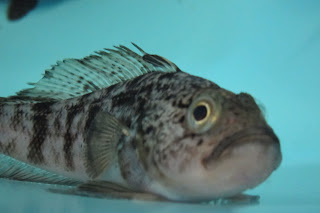Fishing operations are over, as the conditions of the sea ice have rapidly deteriorated, and traversing cracks and soft ice becomes dangerous. We have been working full-time in the lab, sampling and treating the fish that have filled our tanks. Here's a little more of an scientific explanation of what we do at this point:
Once we catch the fish, we allow them to acclimate in the aquarium for at least 48 hours. This is important for several reasons. First, when the fish arrive at the aquarium, they are quite stressed. They have been caught and pulled out of their environment and had to spend two hours in a Pisten Bully riding back to town. After they are transferred to the aquarium, we are able to more closely examine the fish for other signs of stress like gill diseases, parasites or if they are egg bearing females. We do not use these fish in our experiments as their conditions would add another variable to the experiment in which we could not control.
Our experiments are focused on examining how the fish respond to increasing water temperatures. We are trying to determine how they respond at a cellular level. There are many ways of doing this but some of the easiest ways of determining if an organism is under an increased amount of stress is to quantify the amount of stress related proteins they are producing. When a cell encounters an environmental stress, they tend to respond in a universal manner. These stressors can be Ultra Violet Radiation, changes in salinity, increasing temperatures, or toxins. This universal response has been termed Cellular Stress Response or the CSR. When a cell is under stress, it responds by altering the kinds of proteins it makes. These proteins help protect the cell from the different stressors that are acting upon the cell. Some of these proteins are responsible for repairing damaged DNA while others are involved in facilitating proteins to continue to function normally in the face of different stressors. Sometimes, during a stress, cells will stop replicating to prevent damaged DNA from replicating. Stopping (arresting) the cell cycle also allows the cell to re-allocate energy and other resources to other cytoprotective mechanisms. Finally, if a cell or its DNA has become damaged beyond repair, it may actively engage in an automated cell death cycle known as apoptosis. Our team is examining all of these different possible responses that the Antarctic fish could use to survive an environmental stress (such as increasing water temperature).
This year, our team is using both cell preps from hepatocytes (liver cells) and whole tissue samples to examine the cellular response to increasing temperature. Isaac has isolated hepatocytes and exposed them to a range of temperatures and time points. He will be using his samples to examine cell viability (how many cells survive at a certain temperature). He will also be running some of these cells through a flow cytometer to determine what stage of the cell cycle the hepatocytes are in. Finally, he will be staining some samples to determine what percent of the cells have entered apoptosis.
Dan has been isolating liver, gill and white muscle tissue from six different species of fish and exposing them to a range of temperatures and times. Later, he will analyze these samples with a technique called a western blot. This technique helps to quantify the amount of protein is being made at any given time. Dan will determine if the concentrations of a cellular growth arrest/DNA damage protein increases with increasing temperatures. If this protein increases, cells do not continue beyond a certain growth phase and the cell cycle is arrested.
Here is a link to Dan's blog, where he talks about his experiments and includes photos.
These studies are important for several reasons. We hope to help contribute to the building foundation of knowledge that exists regarding how and why cells grow and divide or stop dividing. Further implications from these studies could be used in developing anti-cancer agents. As we continue to learn more about how cells function and what kinds of stimuli cause them to stop replicating will be important details to know as we continue to search out new treatments.

































